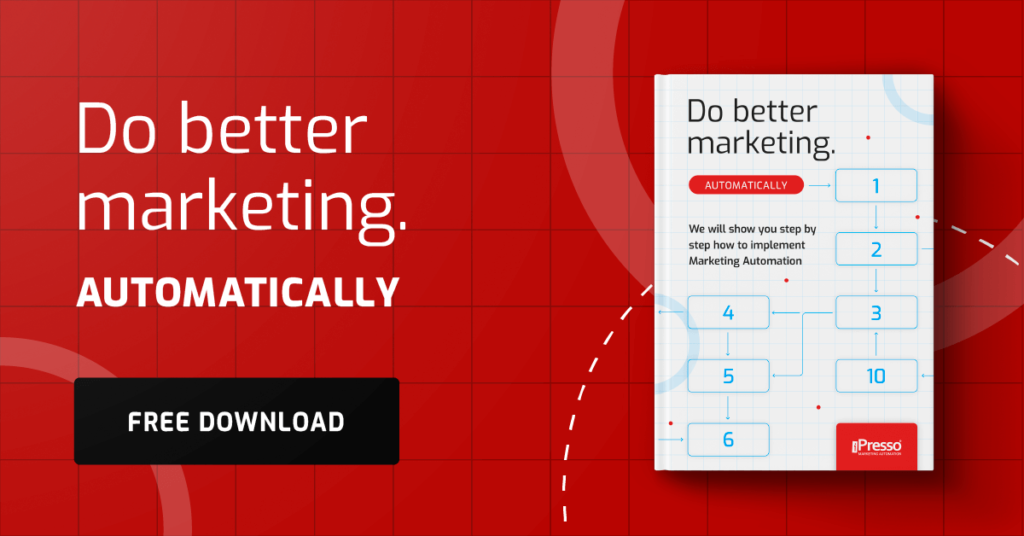It’s not stalking, it’s personalization. See how to use data from Marketing Automation in the sales conversation to make your customer feel special

It’s not enough just to have good products or services. The key to success is personalized communication that hits each customer’s needs. And this is only possible when CRM and Marketing Automation systems work together like a well-coordinated team.
Why integrate CRM with Marketing Automation?
Imagine the situation: a potential customer downloads an e-book from a website and then makes an appointment to speak with a salesman. Without systems integration, the salesman doesn’t know that the customer has already read your materials, what he has read, how much time he has spent on the site. The conversation starts from scratch, and despite the knowledge already acquired, the customer will be treated as if he had not made any interaction with the brand. iPresso can be integrated with CRM tools to create a cohesive sales and marketing ecosystem. This ensures that every interaction with the customer is informed and personalized.
One customer truth
The basis for successful integration is the creation of a single, consistent contact database. Instead of scattered information in different systems, you get a complete picture of every contact – from the first click on an e-mail to the finalization of a transaction. Everything a customer does on the site goes immediately into the CRM. When a sales person updates the status of a lead, the marketing automation system can adjust the communication.
- Data about the customer, such as their locality or job title, is useful for communication and personalization of messages.
- Website visit history, downloaded materials such as e-books or reports, webinar attendance and openings, and email clicks are crucial.
- A customer’s purchase history provides valuable information about his or her preferences, as does the value of transactions and the categories of products he or she has previously purchased. Purchase frequency will help you understand the customer lifecycle, and payment preferences will help you finalize future transactions.
- Scoring awards points for behaviors like page entry, dwell time or link clicks, so the merchant knows if the customer is actually interested in the offer and ready to talk and buy.
Automatic lead nurturing
The system can automatically adjust communications according to the level of customer engagement. Hot leads receive information about a quick contact opportunity, cold leads get educational content, and customers receive case studies and testimonials during the decision process.
Multi-channel sales orchestration. With the integration, you can create emails that reference previous conversations with a sales person, include products tailored to interests and take into account the phase of the sales process. Based on CRM data, the system can adjust prices to the customer segment, suggest complementary products and prepare personalized presentations.
Practical scenarios for use
- Reactivating a cold lead – a customer downloaded an e-book 6 months ago, but did not respond to communications. Thanks to the integration, the system: detects the return to the website, automatically assigns a higher scoring, notifies the merchant of the reactivation and sends a personalized email with updated offers.
- Supporting the sales process – the salesman conducts conversations with the customer. The system tracks which people open e-mails and click on links. In this way, it identifies the most active participants. It then automatically sends follow-up materials tailored to each of them.
- Cross-selling and up-selling – the customer adds products to the shopping cart. The system identifies complementary products and launches an automatic cross-selling campaign, as well as informs the merchant about up-selling opportunities.
Start with a strategy
Before starting integration, define integration goals, map sales processes, identify key customer touchpoints, and select success metrics that will be most important to you. Prepare your data by standardizing formats and standards, and clean the database of duplicates and establish clear procedures for updating information. Monitor key metrics, gather feedback from the team, and regularly optimize processes based on the data collected.
Summary
By synchronizing demographic, behavioral and transactional data, you can create a cohesive ecosystem that automatically personalizes sales communications.
The key to success is a thoughtful approach to integration – from choosing the right data to synchronize, to implementing smart scenarios, to continuously optimizing processes. The result is not only an increase in sales efficiency, but also an improvement in the experience of the customer, who receives communications that are perfectly tailored to his needs and moment in the buying process.
Remember: in a world where the customer has access to unlimited information, the one who can deliver the right information at the right moment wins. Integrating your CRM with Marketing Automation gives you that competitive edge.
Want to learn how to effectively integrate CRM with Marketing Automation in your company? Fill out a short brief – our experts will help you design a system that combines the power of data with the intelligence of automation. Together, we will create a solution that will speed up sales processes and increase conversions.



